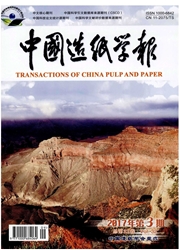

 中文摘要:
中文摘要:
研究了竹子碱法制浆过程中蒸煮工艺条件对草酸根形成的影响,揭示了蒸煮过程中草酸根的形成与纸浆卡伯值的关系。结果表明,在竹子碱法蒸煮过程中,随着蒸煮反应的进行,草酸根的形成量逐渐增加,提高蒸煮最高温度、增大液比、增加用碱量均会导致草酸根形成量的增加,但当用碱量超过2l%时,继续增加用碱量则不会使草酸根的形成量增加。草酸根的形成量随纸浆卡伯值的降低而增加。此外,根据H-因子、用碱量与草酸根形成量的关系,构建了竹子碱法制浆过程中草酸根形成的数学预测模型。该模型的预测准确性较高,可用于竹子碱法制浆过程中草酸根形成的预测。
 英文摘要:
英文摘要:
In this paper, the effects of processing conditions on the oxalate formation during bamboo alkaline pulping were investigated and the relationship between the oxalate formation and the Kappa number of the pulp was also revealed. The results showed that the oxalate con- tent gradually increased with the increasing of cooking temperature, alkali dosage and solid to liquor ratio. While the alkali dosage exceeded 21%, there was no change of oxalate formation even alkali dosage increased continuously. Further, according to the relationship of oxalate formation and H-factor and alkali dosage, a mathematical model was constructed to predict the oxalate content during bamboo alkaline pulp- ing. The model had relatively high accuracy, which could be utilized to predict the oxalate formation during the bamboo alkaline pulping.
 同期刊论文项目
同期刊论文项目
 同项目期刊论文
同项目期刊论文
 期刊信息
期刊信息
